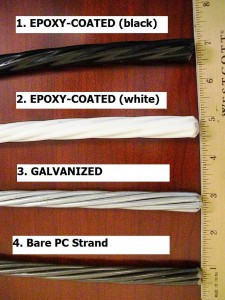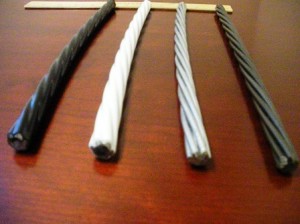Barrier Strand (or Barrier Cable) is primarily used in parking structures for vehicular and/or pedestrian restraint along the ramps or perimeter. This restraint system is different from the ‘Cable Barrier’ used along highways.
Barrier Cable is comprised of a 0.5 inch diameter, 7-wire high-strength steel strand. This strand should meet the requirements of ASTM-A416and Post-Tensioning Institute’s ‘Specification for 7-Wire Steel Strand Barrier Cable Applications.’
Typically, Barrier Cable is exposed to the elements and therefore requires a corrosion-protection system to prevent the steel from rusting. There are several different types of barrier cable that Structural Engineers and Architects can specify for their structure. The pictures and descriptions show the most common types of Barrier Cable used in the United States.
- Plastic-Coated: Plastic-Coated Barrier Cable has an extruded plastic HDPE sheathing around the steel strand to prevent rusting. The protective system is similar to Unbonded Post-Tension strand except the Plastic-Coated Barrier Cable typically does not contain Post-Tension coating (“grease”) inside the sheathing. Therefore, the extruded sheathing has a tighter bond to the steel strand as the interstitial spaces are filled.
- Galvanized Barrier Cable: Galvanized Barrier Cable is zinc-plated per ASTM-A475 to prevent rusting. It is recommended to use galvanized wedges to hold the cable within the corrosion-protected anchorage device.
- Epoxy-Coated: Epoxy-Coated Barrier Cable has thermosetting plastic polymer coating around the steel strand to prevent rusting. Special wedges may be required to hold the cable within the anchorage device.

In terms of costs, the Plastic-Coated system is the cheapest and the Epoxy-Coated is the most expensive. In terms of performance and maintenance, opinions differ and greatly depend on the installation and the end-user. In terms of aesthetics, beauty is in the eye of the beholder!!!

Architects and/or Structural Engineers should also consider the following when designing the Barrier Cable system:
-
Is the Barrier Cable anchorage device embedded in the column, or will a steel angle iron be required to attach to the column?If the anchors are embedded, then the Contractor will have to install the anchors as the columns are erected. If steel angle iron is used, then the sides of the column cannot have any obstruction. Several different anchorage devices are used in either case.
-
What type of anchorage device should be specified? Among the most common types include a galvanized donut/barrel anchor, encapsulated post-tension anchor, “Grabbit”/adjustable anchor, and spring-loaded anchor.
-
What type of wedges should be specified? Depending on the anchorage devices, galvanized 2-piece and 3-piece wedge sets are the most common. Some of the specialized anchorage devices have the wedges included.
-
What areas have restrictions to stressing the Barrier Cable? Again, different anchorage devices would be required.
-
What force should the Barrier Cable be stressed at? Typically, Barrier Cable is stressed to 3 to 7 kips (and back-stressed to 28 kips). Most Barrier Cable is Grade 230, 250 or 270.
-
How many rows of Barrier Cable are required to protect pedestrian and restrain vehicles? The PTI Barrier Cable Specification defines the requirements per UBC Building Code. Local Codes or special circumstances should be factored.
Visit the AMSYSCO Inc. website for more information about Barrier Cable and other Post-Tensioning products.
– Neel Khosa, AMSYSCO, Inc.
____________________________________________
Copyright © 2010 by AMSYSCO, Inc. All rights reserved.













